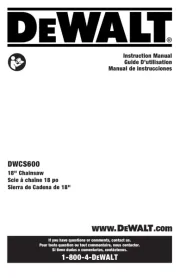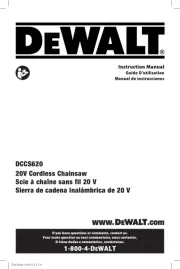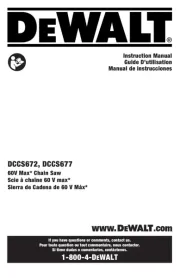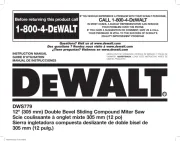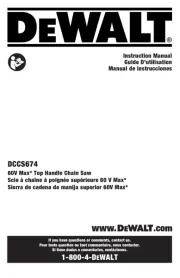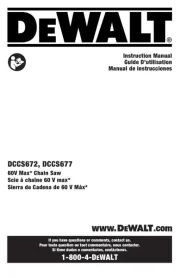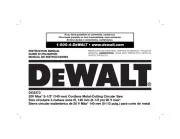DEWALT Industrial Tool Co., 701 East Joppa Road, Towson, MD 21286
(JUN14) Part No. N384537 DW364, DW384 Copyright © 1997, 2000, 2003, 2004, 2007, 2014 DEWALT
The following are trademarks for one or more D WALT power tools: the yellow and black color E
scheme; the “D” shaped air intake grill; the array of pyramids on the handgrip; the kit box
configuration; and the array of lozenge-shaped humps on the surface of the tool.
DW364 7-1/4" (180 mm) Heavy Duty Circular Saw
DW384 8-1/4" (209 mm) Heavy Duty Circular Saw
DW364 Scie circulaire de service intensif de 180 mm (7-1/4 po)
DW384 Scie circulaire de service intensif de 209 mm (8-1/4 po)
DW364 Sierra circular de 180 mm (7-1/4") para trabajo pesado
DW384 Sierra circular de 209 mm (8-1/4") para trabajo pesado
INSTRUCTION MANUAL
GUIDE D’UTILISATION
MANUAL DE INSTRUCCIONES
INSTRUCTIVO DE OPERACIÓN, CENTROS DE SERVICIO Y PÓLIZA DE
GARANTÍA. ADVERTENCIA: LÉASE ESTE INSTRUCTIVO ANTES DE
USAR EL PRODUCTO.
If you have questions or comments, contact us.
Pour toute question ou tout commentaire, nous contacter.
Si tiene dudas o comentarios, contáctenos.
1-800-4-D WALT • www.dewalt.comE
Defi nitions: Safety Guidelines
The definitions below describe the level of severity for each signal word. Please read the
manual and pay attention to these symbols.
DANGER: Indicates an imminently hazardous situation which, if not avoided, will
result in death or serious injury.
WARNING: Indicates a potentially hazardous situation which, if not avoided, could
result in death or serious injury.
CAUTION: Indicates a potentially hazardous situation which, if not avoided, may result
in minor or moderate injury.
NOTICE: may Indicates a practice which, if not avoided, not related to personal injury
result in property damage.
IF YOU HAVE ANY QUESTIONS OR COMMENTS ABOUT THIS OR ANY D WALT TOOL, CALL E
US TOLL FREE AT: 1-800-4-DEWALT (1-800-433-9258).
WARNING: To reduce the risk of injury, read the instruction manual.
General Power Tool Safety Warnings
WARNING! Read all safety warnings and all instructions. Failure to follow the warnings
and instructions may result in electric shock, fire and/or serious injury.
SAVE ALL WARNINGS AND INSTRUCTIONS
FOR FUTURE REFERENCE
The term “power tool” in the warnings refers to your mains-operated (corded) power tool or
battery-operated (cordless) power tool.
1) WORK AREA SAFETY
a) Keep work area clean and well lit. Cluttered or dark areas invite accidents.
b) Do not operate power tools in explosive atmospheres, such as in the presence of
flammable liquids, gases or dust. Power tools create sparks which may ignite the dust
or fumes.
c) Keep children and bystanders away while operating a power tool. Distractions can
cause you to lose control.
2) ELECTRICAL SAFETY
a) Power tool plugs must match the outlet. Never modify the plug in any way. Do not
use any adapter plugs with earthed (grounded) power tools. Unmodified plugs and
matching outlets will reduce risk of electric shock.
b) Avoid body contact with earthed or grounded surfaces such as pipes, radiators,
ranges and refrigerators. There is an increased risk of electric shock if your body is
earthed or grounded.
c) Do not expose power tools to rain or wet conditions. Water entering a power tool will
increase the risk of electric shock.
d) Do not abuse the cord. Never use the cord for carrying, pulling or unplugging the
power tool. Keep cord away from heat, oil, sharp edges or moving parts. Damaged
or entangled cords increase the risk of electric shock.
e) When operating a power tool outdoors, use an extension cord suitable for outdoor
use. Use of a cord suitable for outdoor use reduces the risk of electric shock.
f) If operating a power tool in a damp location is unavoidable, use a ground fault
circuit interrupter (GFCI) protected supply. Use of a GFCI reduces the risk of electric
shock.
3) PERSONAL SAFETY
a) Stay alert, watch what you are doing and use common sense when operating a
power tool. Do not use a power tool while you are tired or under the influence of
drugs, alcohol or medication. A moment of inattention while operating power tools may
result in serious personal injury.
b) Use personal protective equipment. Always wear eye protection. Protective
equipment such as dust mask, non-skid safety shoes, hard hat, or hearing protection used
for appropriate conditions will reduce personal injuries.
c) Prevent unintentional starting. Ensure the switch is in the off position before
connecting to power source and/or battery pack, picking up or carrying the tool.
Carrying power tools with your finger on the switch or energizing power tools that have the
switch on invites accidents.
d) Remove any adjusting key or wrench before turning the power tool on. A wrench or
a key left attached to a rotating part of the power tool may result in personal injury.
e) Do not overreach. Keep proper footing and balance at all times. This enables better
control of the power tool in unexpected situations.
f) Dress properly. Do not wear loose clothing or jewelry. Keep your hair, clothing and
gloves away from moving parts. Loose clothes, jewelry or long hair can be caught in
moving parts.
g) If devices are provided for the connection of dust extraction and collection
facilities, ensure these are connected and properly used. Use of dust collection can
reduce dust-related hazards.
4) POWER TOOL USE AND CARE
a) The Do not force the power tool. Use the correct power tool for your application.
correct power tool will do the job better and safer at the rate for which it was designed.
b) Do not use the power tool if the switch does not turn it on and off. Any power tool
that cannot be controlled with the switch is dangerous and must be repaired.
c) Disconnect the plug from the power source and/or the battery pack from the
power tool before making any adjustments, changing accessories, or storing
power tools. Such preventive safety measures reduce the risk of starting the power tool
accidentally.
d) Store idle power tools out of the reach of children and do not allow persons
unfamiliar with the power tool or these instructions to operate the power tool.
Power tools are dangerous in the hands of untrained users.
e) Maintain power tools. Check for misalignment or binding of moving parts,
breakage of parts and any other condition that may affect the power tool’s
operation. If damaged, have the power tool repaired before use. Many accidents are
caused by poorly maintained power tools.
f) Keep cutting tools sharp and clean. Properly maintained cutting tools with sharp cutting
edges are less likely to bind and are easier to control.
g) Use the power tool, accessories and tool bits, etc. in accordance with these
instructions, taking into account the working conditions and the work to be
performed. Use of the power tool for operations different from those intended could result
in a hazardous situation.
5) SERVICE
a) Have your power tool serviced by a qualified repair person using only identical
replacement parts. This will ensure that the safety of the power tool is maintained.
Safety Instructions for All Saws
CUTTING PROCEDURES
a) DANGER: Keep hands away from cutting area and the blade. Keep your second
hand on auxiliary handle, or motor housing. If both hands are holding the saw, they
cannot be cut by the blade.
b) Do not reach underneath the workpiece. The guard cannot protect you from the blade
below the workpiece.
c) Adjust the cutting depth to the thickness of the workpiece. Less than a full tooth of
the blade teeth should be visible below the workpiece.
d) Never hold piece being cut in your hands or across your leg. Secure the workpiece
to a stable platform. It is important to support the work properly to minimize body
exposure, blade binding, or loss of control.
e) Hold the power tool by insulated gripping surfaces only, when performing an
operation where the cutting tool may contact hidden wiring or its own cord.
Contact with a “live” wire will also make exposed metal parts of the power tool “live” and
could give the operator an electric shock.
f) When ripping, always use a rip fence or straight edge guide. This improves the
accuracy of cut and reduces the chance of blade binding.
g) Always use blades with correct size and shape (diamond versus round) of arbor
holes. Blades that do not match the mounting hardware of the saw will run eccentrically,
causing loss of control.
h) Never use damaged or incorrect blade washers or bolt. The blade washers and bolt
were specially designed for your saw, for optimum performance and safety of operation.
Further Safety Instructions for All Saws
KICKBACK CAUSES AND RELATED WARNINGS
– Kickback is a sudden reaction to a pinched, bound or misaligned saw blade, causing an
uncontrolled saw to lift up and out of the workpiece toward the operator;
– When the blade is pinched or bound tightly by the kerf closing down, the blade stalls and
the motor reaction drives the unit rapidly back toward the operator;
– If the blade becomes twisted or misaligned in the cut, the teeth at the back edge of the blade
can dig into the top surface of the wood causing the blade to climb out of the kerf and jump
back toward the operator.
Kickback is the result of saw misuse and/or incorrect operating procedures or conditions and can
be avoided by taking proper precautions as given below:
a) Maintain a firm grip with both hands on the saw and position your arms to resist
kickback forces. Position your body to either side of the blade, but not in line with
the blade. Kickback could cause the saw to jump backwards, but kickback forces can be
controlled by the operator, if proper precautions are taken.
b) When blade is binding, or when interrupting a cut for any reason, release the
trigger and hold the saw motionless in the material until the blade comes to a
complete stop. Never attempt to remove the saw from the work or pull the saw
backward while the blade is in motion or kickback may occur. Investigate and take
corrective actions to eliminate the cause of blade binding.
c) When restarting a saw in the workpiece, center the saw blade in the kerf and
check that saw teeth are not engaged into the material. If saw blade is binding, it may
walk up or kickback from the workpiece as the saw is restarted.
d) Large Support large panels to minimise the risk of blade pinching and kickback.
panels tend to sag under their own weight. Supports must be placed under the panel on
both sides, near the line of cut and near the edge of the panel.
e) Do not use dull or damaged blades. Unsharpened or improperly set blades produce
narrow kerf causing excessive friction, blade binding and kickback.
f) Blade depth and bevel adjusting locking levers must be tight and secure before
making cut. If blade adjustment shifts while cutting, it may cause binding and kickback.
g) The Use extra caution when sawing into existing walls or other blind areas.
protruding blade may cut objects that can cause kickback.
LOWER GUARD FUNCTION
a) Check lower guard for proper closing before each use. Do not operate the saw if
lower guard does not move freely and close instantly. Never clamp or tie the lower
guard into the open position. If saw is accidentally dropped, lower guard may be bent.
Raise the lower guard with the retracting handle and make sure it moves freely and does
not touch the blade or any other part, in all angles and depths of cut.
b) Check the operation of the lower guard spring. If the guard and the spring are
not operating properly, they must be serviced before use. Lower guard may operate
sluggishly due to damaged parts, gummy deposits, or a build-up of debris.
c) Lower guard should be retracted manually only for special cuts such as “plunge
cuts” and “compound cuts.” Raise lower guard by retracting handle and as soon
as blade enters the material, the lower guard must be released. For all other sawing,
the lower guard should operate automatically.
d) Always observe that the lower guard is covering the blade before placing saw
down on bench or floor. An unprotected, coasting blade will cause the saw to walk
backwards, cutting whatever is in its path. Be aware of the time it takes for the blade to stop
after switch is released.
Additional Specifi c Safety Instructions for Circular Saws
WARNING: Do not use abrasive wheels or blades.
WARNING: Do not use water feed attachments.
WARNING: Blades coast after turn off. Serious personal injury may result.
• Use clamps or another practical way to secure and support the workpiece to a stable
platform. Holding the work by hand or against your body leaves it unstable and may lead to
loss of control.
• Keep your body positioned to either side of the blade, but not in line with the saw
blade. Kickback could cause the saw to jump backwards (Refer to KICKBACK CAUSES
AND RELATED WARNINGS and ). KICKBACK
• Avoid cutting nails. Inspect for and remove all nails from lumber before cutting.
• Accessories must be rated for at least the speed recommended on the tool warning
label. Wheels and other accessories running over rated speed can fly apart and cause injury.
Accessory ratings must always be above tool speed as shown on tool nameplate.
• Always make sure the saw is clean before using.
• Stop using this saw and have it properly serviced if any unusual noise or abnormal operation
occcurs.
• Always be sure all components are mounted properly and securely before using tool.
• Always handle the saw blade with care when mounting or removing it.
• Always wait until the motor has reached full speed before starting a cut.
• Always keep handles dry, clean and free of oil and grease. Hold the tool firmly with both hands
when in use.
• Always be alert at all times, especially during repetitive, monotonous operations. Always be sure
of position of your hands relative to the blade.
• Stay clear of end pieces that may fall after cutting off. They may be hot, sharp and/or heavy.
Serious personal injury may result.
• Replace or repair damaged cords. Make sure your extension cord is in good condition. Use
only 3-wire extension cords that have 3-prong grounding-type plugs and 3-pole receptacles
that accept the tool’s plug.
• Air vents often cover moving parts and should be avoided. Loose clothes, jewelry or long
hair can be caught in moving parts.
• An extension cord must have adequate wire size (AWG or American Wire Gauge) for
safety. The smaller the gauge number of the wire, the greater the capacity of the cable, that
is 16 gauge has more capacity than 18 gauge. An undersized cord will cause a drop in line
voltage resulting in loss of power and overheating. When using more than one extension to
make up the total length, be sure each individual extension contains at least the minimum wire
size. The following table shows the correct size to use depending on cord length and nameplate
ampere rating. If in doubt, use the next heavier gauge. The smaller the gauge number, the
heavier the cord.
Minimum Gauge for Cord Sets
Ampere Rating
Volts Total Length of Cord in Feet (meters)
120 V 25 (7.6) 50 (15.2) 100 (30.5) 150 (45.7)
240 V 50 (15.2) 100 (30.5) 200 (61.0) 300 (91.4)
More
Than
Not More
Than AWG
0 6 18 16 16 14
6 10 18 16 14 12
10 12 16 16 14 12
12 16 14 12 Not Recommended
WARNING: ALWAYS use safety glasses. Everyday eyeglasses are NOT safety glasses. Also use
face or dust mask if cutting operation is dusty. ALWAYS WEAR CERTIFIED SAFETY EQUIPMENT:
• ANSI Z87.1 eye protection (CAN/CSA Z94.3),
• ANSI S12.6 (S3.19) hearing protection,
• NIOSH/OSHA/MSHA respiratory protection.
WARNING: Some dust created by power sanding, sawing, grinding, drilling, and other
construction activities contains chemicals known to the State of California to cause cancer, birth
defects or other reproductive harm. Some examples of these chemicals are:
• lead from lead-based paints,
• crystalline silica from bricks and cement and other masonry products, and
• arsenic and chromium from chemically-treated lumber.
Your risk from these exposures varies, depending on how often you do this type of work. To
reduce your exposure to these chemicals: work in a well ventilated area, and work with approved
safety equipment, such as those dust masks that are specially designed to filter out microscopic
particles.
• Avoid prolonged contact with dust from power sanding, sawing, grinding, drilling, and
other construction activities. Wear protective clothing and wash exposed areas with
soap and water. Allowing dust to get into your mouth, eyes, or lay on the skin may promote
absorption of harmful chemicals.
WARNING: Use of this tool can generate and/or disperse dust, which may cause serious and
permanent respiratory or other injury. Always use NIOSH/OSHA approved respiratory protection
appropriate for the dust exposure. Direct particles away from face and body.
WARNING: Cutting plastics, sap coated wood, and other materials may cause melted material
to accumulate on the blade tips and the body of the saw blade, increasing the risk of blade
overheating and binding while cutting.
WARNING: Always wear proper personal hearing protection that conforms to ANSI
S12.6 (S3.19) during use. Under some conditions and duration of use, noise from this product
may contribute to hearing loss.
• The label on your tool may include the following symbols. The symbols and their definitions are
as follows:
V .....................volts A .........................amperes
Hz ...................hertz W ........................watts
min .................minutes or AC .............alternating current
or DC .....direct current or AC/DC......alternating or direct current
...................Class I Construction no .......................no load speed
....
....
....
.........
.....
.....
.........
....
....
........
....
....
........
....
....
......
..
..
..(grounded) n .........................rated speed
................... Class II Construction .......................earthing terminal
(double insulated) ........................safety alert symbol
…/min ............per minute BPM ...................beats per minute
IPM .................impacts per minute RPM ...................revolutions per minute
SPM ...............strokes per minute sfpm ...................surface feet per minute
SAVE THESE INSTRUCTIONS FOR FUTURE USE
Motor
Be sure your power supply agrees with the nameplate marking. Voltage decrease of more than
10% will cause loss of power and overheating. DEWALT tools are factory tested; if this tool does
not operate, check power supply.
COMPONENTS (Fig. 1, 2)
A. End cap F. Blade
B. Trigger switch G. Outer clamp washer
C. Lower blade guard retracting lever H. Blade clamping screw
D. Lower blade guard I. Blade lock
E. Inner clamp washer J. Shoe
INTENDED USE
This heavy-duty circular saw is designed for professional cutting of wood.
DO NOT use under wet conditions or in presence of flammable liquids or gases.
This heavy-duty circular saw is a professional power tool. let children come into contact DO NOT
with the tool. Supervision is required when inexperienced operators use this tool.
Electric Brake
Your saw has an automatic electric brake which is designed to stop the blade from coasting in
about two seconds after you release the trigger switch (B). It is useful when making certain cuts in
wood where a coasting blade would result in a wide, imprecise cut.
Occasionally, under certain conditions, the brake will not function properly and won’t stop the
saw in the 2 seconds discussed above. If this condition persists, turn the saw on and off four
